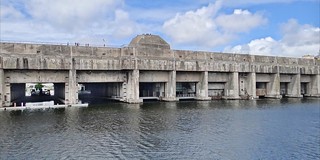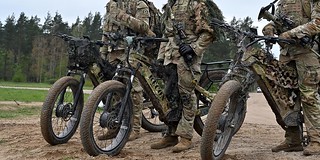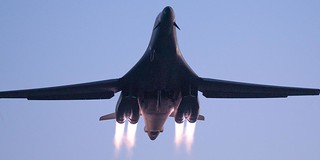The Spanish Navy points out options to replace its oldest patrol ships
Spain has a long coastline that includes its coasts on the Iberian Peninsula, the Balearic and Canary Islands and its places in North Africa.
To monitor these coasts, the Maritime Action Force (FAM) of the Spanish Navy has several types of vessels:
- Six Meteor Class ocean patrol vessels (called Maritime Action Vessels, BAM), very modern and capable of covering different missions.
- Three ocean patrol vessels of the Chilreu Class, the most modern of which has already been in operation for 20 years.
- Three Anaga Class high-altitude patrol vessels, all of them with 43 years in active service (they have been in service since 1981) and the last in a total series of ten.
- Three Serviola Class high-altitude patrol vessels, in service since 1991-1992.
- Two coastal patrol vessels of the Toralla Class, incorporated in 1987 and 1989.
- Five smaller patrol boats, including one of the Navy's oldest units, the "Cabo Fradera" P-201 (from 1963), which is used to guard the international stretch of the Miño River.

Today it is published the March 2024 issue of the Revista General de Marina, an official publication of the Spanish Navy that includes an interesting article about small patrol cars, written by Ship Lieutenant Juan Manuel Robles Arnao.

The article begins with a reference to an old acquaintance from the Galician estuaries, the Anaga Class patrol ship "Tabarca" P-28, which is based at the Torpedo Dock of the Naval Military School of Marin. The article points out the limitations of these patrol vessels, due to their age: "they lack satellite communications systems that allow them to link with the COVAM in real time in the event of detecting an incident or threat to maritime security. That is why its radius of action is very limited to coastal areas within radio range and telephone coverage."

These patrol ship have "very old and impractical weapons for their operational environment", only consisting of a 76 mm Mk22 main gun in the bow and an Oerlikon Mod cannon 5 20 mm TG in the stern, without having more defense elements. "The lack of redundancy in vital equipment, the lack of an electro-optical surveillance system and a very small semi-rigid boat are critical aspects for its performance," says the author, and adds: "The Toralla class presents similar limitations, with its reduced crew (a single officer) preventing them from spending more than ten hours at sea."

Added to these shortcomings are maintenance problems derived from the age of these ships, with a shortage of spare parts and increasingly longer periods of immobilization. A problem that is aggravated by the recent withdrawal of the last patrol ship (former corvettes) of the Discovered Class: "The situation of the FAM is currently undergoing a notable weakening due to the casualties of the last two «corvettes»", indicates the aforementioned article in the General Navy Magazine.

The article points out possible options in the Spanish naval industry to replace these small patrol ship. The first one mentioned is the Patrol H35 series or Guardamar Class, from Armon Shipyards. The Maritime Service of the Civil Guard has five units, incorporated between 2019 and 2023, and Maritime Rescue another five, in service since 2008 and 2009 (the oldest) and the most recent in 2023. They have an aluminum hull, between 31.9 and 40 meters in length (depending on the variant) and a maximum speed of 26 knots, with a range of 1,300 miles. "These units have a high degree of automation that allows their crew of eight people to control the government", highlights the article in the General Navy Magazine, which also points out "the excellent habitability standards that this series presents."

Another of the options indicated are the Rodman 130 patrol ship and Rodman 138 of the Rodman shipyard, from Vigo. The Rodman 138 is 43 meters long, with a maximum speed of 23 knots and a range of 2,000 miles. It is currently used by the Customs Surveillance Service and by the Coast Guard of the Xunta de Galicia. These are patrol ship similar to those of the Armon Shipyards, but the article states: "The price of these units is higher, since the Tax Agency paid more than eight million euros for a single ship in 2021", compared to the 26 million euros that four Guardamar Class patrol ship of the Civil Guard cost.

The Ship Lieutenant Robles Arnao points out a third option: Navantia's Avante 300 Project, of which no ship has yet been built. "According to the shipyard, it is a much more ambitious ship, of larger size (600 tons and 55 meters in length) and better capacities", says Robles. This search would have a propulsion based on "four waterjet thrusters and two diesel engines, which would allow it to reach a speed of 35 knots and a range of 1,000 miles". Its drawback is that it would be more expensive than the patrol ship indicated above, "something that is far from the needs of the Navy if it were to be studied as a possible substitute for small patrol ship."
You can see the article from the General Navy Magazine clicking here (PDF).
---
Main photo: Elentir.
|
Don't miss the news and content that interest you. Receive the free daily newsletter in your email: |
- Most read
- The United States Army shows its electric bicycles for reconnaissance missions
- The Saint-Nazaire submarine base, one of the last bastions of nazi Germany
- The brutal 'touch and go' of a Lufthansa Boeing 747 at Los Angeles Airport
- Portugal confirms that it has begun its transition to the F-35 and indicates bad news for Spain
- The Harrier IIs of the Spanish Navy fly with F-16 and F-4E of the Hellenic Air Force
- The anonymous Czech prisoner who saved an American B-17 bomber in World War II
- The firearms used by the Pontifical Swiss Guard, the smallest army in the world

 ES
ES







Opina sobre esta entrada: